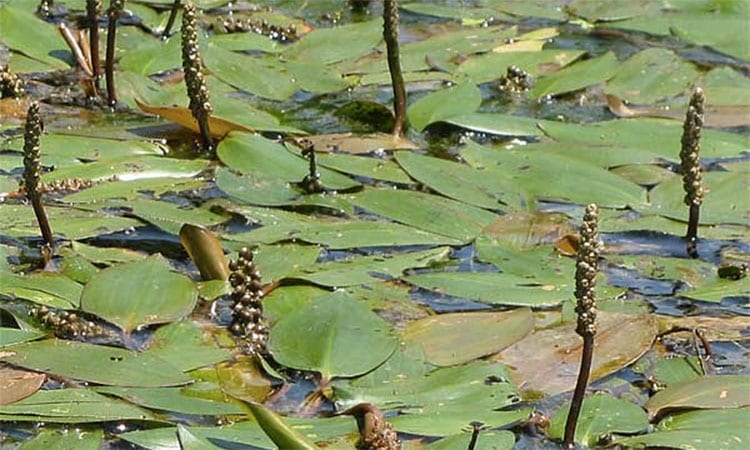What is American Pondweed
Rootless mass of floating and submerged oval-shaped leaves with no roots. Dense spiked flowers. Brownish seeds on slender stalks.
- English Name: American Pond Weed
- Latin Name: Potamogeton Nodosus
- Propogate: Seeds, fragmentation, new shoots
- Symptoms: Mass of floating oval-shaped leaves
- Dangers: Is a threat to submerged vegetation because it blocks sunlight, Boating tangles in props.
The Nuisance Power of American Pondweed
The defining character of the American Pondweed is that it grows rapidly, taking over a lake or dam in no time. This proficiency is in part down to the weed’s liberal system of propagation. New plants are not only produced from seeds but also from fragments of older plants and shoots. It also helps that it is a perennial plant that grows through the seasons. In the wild, American Pondweed is a useful addition to the ecosystem. Ducks and other water birds and animals love it and eat copious amounts of it. The weed also makes a good habitat for small marine invertebrates which in turn serve as food for fish and amphibian such as flogs. But where there are no ducks and other animals to keep the weed in check, the Pondweed can be both a nuisance and a danger to the ecosystem. Its massive mats of freely floating leaves block sunlight from reaching other plants and make it nearly impossible to fish or navigate in the water.
How Do You Control American Pondweed
Like all other water weeds, mechanical removal with rakes or nets will clear away American Pondweed. But the weed will be right back soon enough because any remaining fragment will quickly grow into a full plant. A biological option is to unleash grass carps on the weed and hope the insects keep the weed in check. Some herbicides may also be used with reasonable levels of success. If, however, the idea is to totally eradicate the weed, a good alternative is to use the Lake Bottom Blanket or the DeSkuzzer, two of our weeding products specifically designed to deal with stubborn weeds like the American pondweed. The “blanket” – which has already been used in over 700 lakes in over 39 states – is made of a material that is lighter than water so as to float close to the bottom of the lake while leaving space for fish and other aquatic animals to move about.
It works by pinning down the weed below the water surface and blocking away sunlight. On average, four weeks are enough to eradicate the most stubborn weed. For floating weeds like the American Pondweed, the Deskuzzer can be used to collect the bulk of the floating material on top of the water. The Deskuzzer is a 5 foot wide floating seine with sturdy abrasion resistant guard and a 24-foot pull line. The screen is made of ultra-tough material that is quite effective at collecting weeds and other water debris as it is dragged along the water surface. The Deskuzzer is of course not as thorough in killing weeds as the Lake Bottom Blanket but it is a lot more efficient than plain nets or rakes. It is best used in small water bodies, such as ponds.

